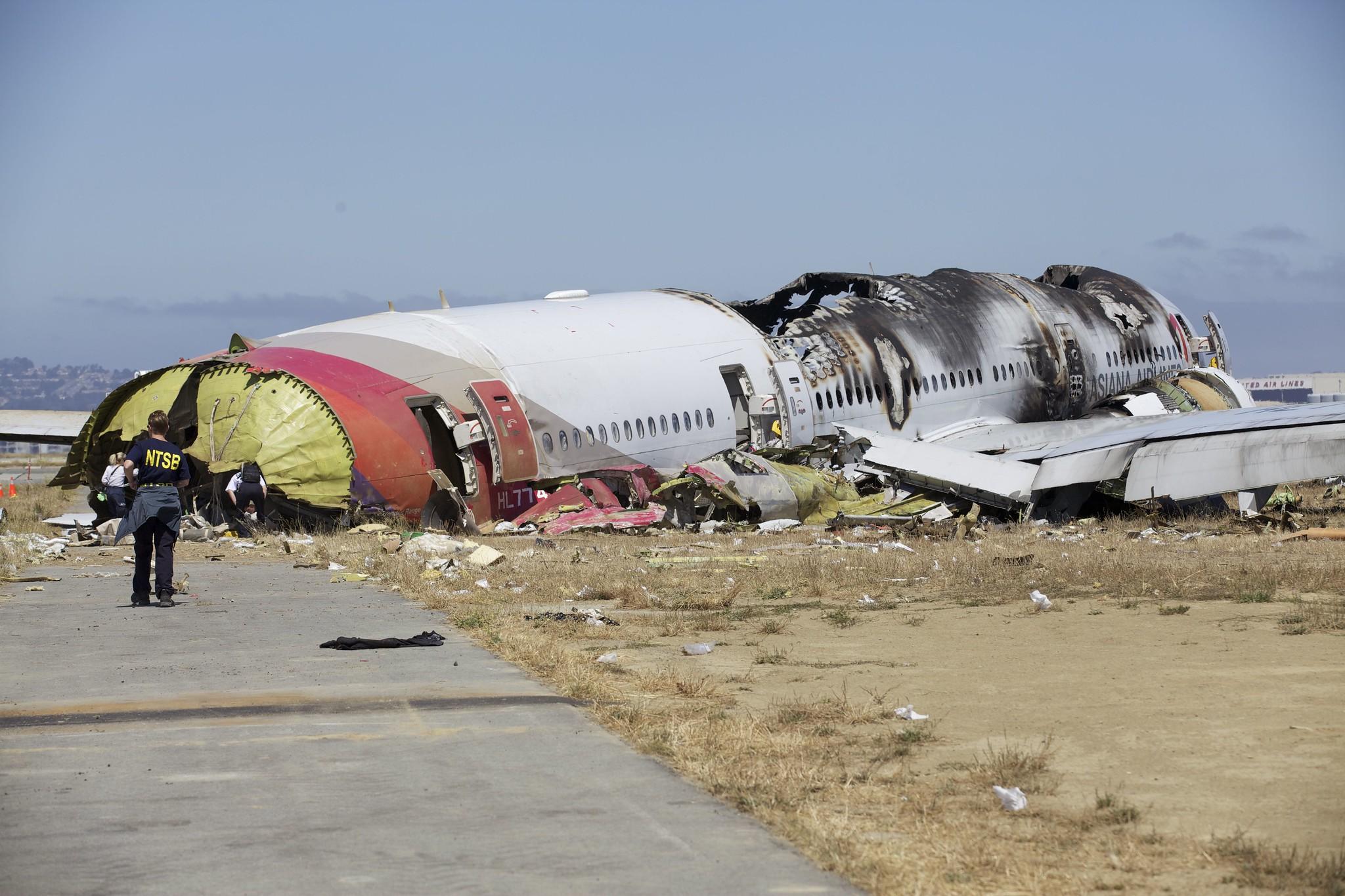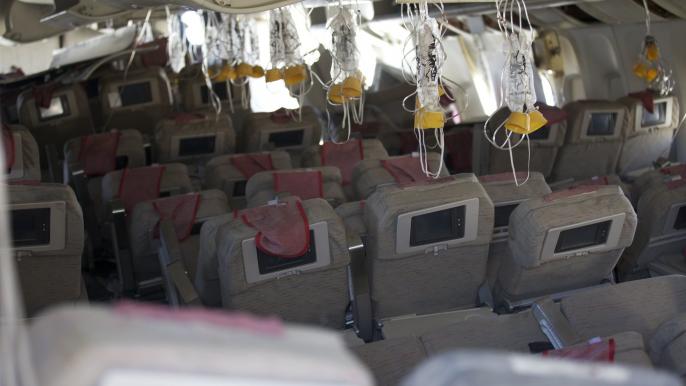
Author’s Note: This is the first of a three-part article that compares U.S., British and Pakistani safety board reports. As you read them, see if you can discern where I might be going with these articles. The reports are, for the most part, directly quoted, but I have inserted comments and cut portions for clarity and the purpose of proving my point.
At about 1128 Pacific Daylight Time, a Boeing 777-200ER (Korean registration HL7742), operating as Asiana Airlines Flight 214, was on approach to Runway 28L when it struck a seawall at San Francisco International Airport (KSFO). Three of the 291 passengers were fatally injured; 40 passengers, eight of the 12 flight attendants, and one of the four flight crewmembers received serious injuries. The other 248 passengers, four flight attendants and three flight crewmembers received minor injuries or were not injured. The airplane was destroyed by impact forces and a post-crash fire. Flight 214 was a regularly scheduled international passenger flight from Incheon International Airport (RKSI), Seoul, operating under the provisions of 14 CFR Part 129. Visual meteorological conditions (VMC) prevailed, and an instrument flight rules (IFR) flight plan was filed.
Flight 214 first contacted NCT, Northern California Terminal Radar Approach Control, at 1111:05 when the 777 was descending through 11,325 ft. to 11,000 ft. NCT instructed the pilot to depart the SFO VOR heading 140 deg. and advised him to expect a visual approach to Runway 28L. Over the next 9 min., various vectors and altitudes were assigned until, at 1121:57, the pilot reported the airport in sight. The aircraft was about 16 mi. from the end of the runway. The controller instructed the pilot to turn left to 310 deg. and cleared him for the visual approach to Runway 28L. The aircraft intercepted the final approach course about 14 mi. from the end of Runway 28L at 4,500 ft. All Nippon Airways Flight 8, also a 777, was immediately preceding Flight 214 on the visual approach, and intercepted the final approach course about 11 mi. from the end of Runway 28L. At that point, Flight 8 was descending through 4,100 ft. When Flight 214 passed the same point on final approach, it also was descending through 4,100 ft.
Cleared for the visual approach by NCT, the Asiana pilots attempted contact with SFO Tower controllers at 1125:56, transmitting “Good morning Asiana two one four, final 7 mi. out two eight left.” There was no reply from SFO Tower. At 1126:59, Asiana 214 re-attempted communications with SFO Tower, transmitting “Asiana two one four short final.” At 1127:08, the SFO Tower local controller responded to the pilot of Flight 214, transmitting “Asiana two one four heavy San Francisco tower runway two eight left cleared to land.” At 1127:10, the pilot acknowledged the clearance to land. At 1128:08, SFO Tower instructed SkyWest Airlines Flight 6389 to go around. At 1128:26, the pilot of Flight 214 contacted SFO Tower, which responded “Asiana two fourteen heavy emergency vehicles are responding.” At 1128:33, Asiana 214 made a second attempt to contact SFO Tower, which responded, “Emergency vehicles are responding.” At 1128:38, Flight 214 transmitted “uh, uh, [unintelligible] uh, Asiana [unintelligible].”

The SFO weather for July 6, 2013, was obtained from the KSFO Automatic Surface Observing System (ASOS). At 1056 PDT, the SFO ASOS weather was reported as wind from 210 deg. at 6 kt.; visibility, 10 sm; few clouds at 1,600 ft.; temperature, 18C; dew point, 10C; and altimeter setting of 29.82 in. of mercury.
The SFO Automatic Terminal Information Service (ATIS) broadcast at 1056 PDT confirmed the weather and advised flight crews that the airport was using Runways 28 L/R for landing and the field was using simultaneous charted visual flight procedures to land on them. Depart Runway 1L/R. NOTAMs: 28L/R glideslope out of service (the first link in a chain of events?); Runway 28L/R approach light system out of service. Read back of all runway holding instructions was required.
Beginning in July 2012, SFO runways had undergone a construction project to make them compliant with a congressionally mandated requirement to increase the runway safety areas (RSAs). The construction project increased the RSAs to a full 1,000 ft. by extending the length of the runways to the west, and moving the Runway 28L threshold west to achieve the required RSA. This created an RSA that began at the sea wall and extended 1,000 feet to the Runway 28L threshold. Also, as part of the construction program, the glideslope for the Runway 28L instrument landing system (ILS) was taken out of service on June 1, 2013, in order to move the glideslope antenna. The new glideslope antenna was scheduled to be commissioned on Aug. 22, 2013. A flight check conducted on July 2, 2013, certified the precision approach path indicator (PAPI) lights serving Runway 28L with a 2.85-deg. glideslope.
There was on-the-job training in progress on the local control (LC) position. The certified professional controller (CPC) acting as instructor had been certified at SFO for two years and had previous CPC experience at the Livermore and Oakland ATC towers. Both air traffic controllers had been on position for about 1 hr., 10 min. when the accident occurred. The front-line manager on duty for the shift was out of the tower cab on a break. He had been on position for 2 hr., 21 min. before being relieved by the traffic management coordinator, who assumed controller-in-charge duties. All of this information serves to show that operations were being conducted in a routine manner.
The NTSB determined the probable cause(s) of this accident to be the flight crew's mismanagement of the airplane's descent during the visual approach; the pilot flying's unintended deactivation of automatic airspeed control; the flight crew's inadequate monitoring of airspeed; and the flight crew's delayed execution of a go-around after they became aware that the airplane was below acceptable glidepath and airspeed tolerances. Contributing to the accident were (1) the complexities of the autothrottle and autopilot flight director systems that were inadequately described in Boeing's documentation and Asiana's pilot training, which increased the likelihood of mode error; (2) the flight crew's nonstandard communication and coordination regarding the use of the autothrottle and autopilot flight director systems; (3) the pilot flying's inadequate training on the planning and executing of visual approaches; (4) the pilot monitoring/instructor pilot's inadequate supervision of the pilot flying; and (5) flight crew fatigue, which likely degraded their performance.





